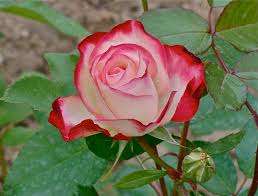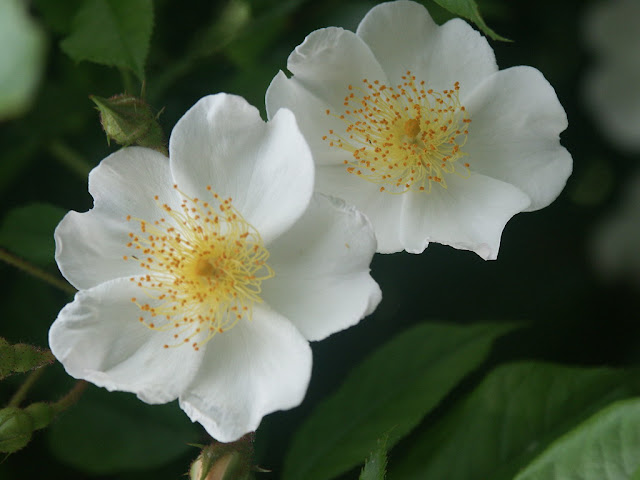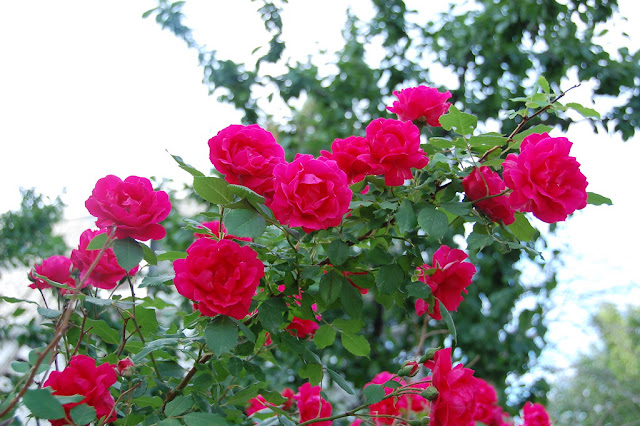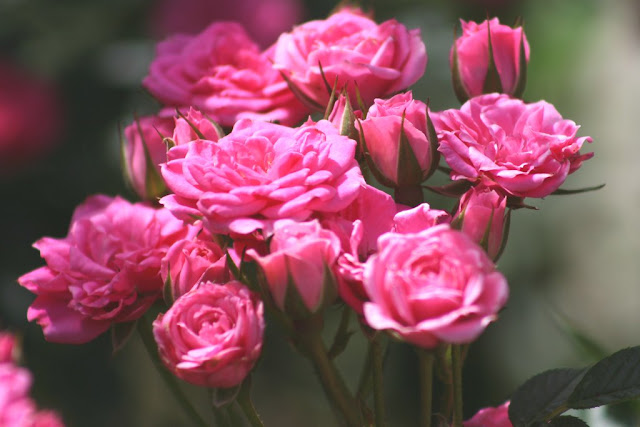Rose, the queen of flowers, is adored by human beings all over the world and is used as an offering to the Hindu deities, for the hairdo to the ladies and for making of garlands, bouquets, buttonholes, wreaths as well as floral arrangements. It is an evergreen, a hardy shrub which can be grown throughout the country with varying degree of success.
Due to variation in the habit of growth, it is easy to select kinds for several purposes in the garden such as for covering walls, arches, pergolas, for bedding, for edging and hedging, and for pot culture.
The demand for its cut-flowers is increasing rapidly in internal as well as foreign markets. Thus, its cultivation in India is now becoming more and more rewarding and economical. It is grown for cut-flowers, making essential oil, rose water, and gulkand. It is mainly grown in Rajasthan, Maharashtra, Punjab, U.P., Delhi, West Bengal, Karnataka, and Tamil Nadu.
Rose oil and Gulkand are commercial products obtained from rose petals mainly from Rosa damascena and R. bourboniana. These species are highly scented and being grown in Aligarh, Kannauj, Ghazipur, Ballia and Jaunpur in U.P., Haldighati and Pushkar in Rajasthan and in some parts of Tamil Nadu and Punjab.
Classification of Rose Plant ;
Modern roses are classified into the following groups:
1. Hybrid Tea (H.T.).
Obtained by crossing Hybrid perpetual and Teal roses. It is characterized by the production of single bloom on long canes elongated buds and good keeping quality. The most popular group of rose.
2. Floribunda (Fl.).
Obtained by crossing Hybrid Tea and dwarf polyantha.It is characterised by the production of flowers in clusters with bigger size and better shape than polyantha but blooms are smaller than Hybrid Teas.
3. Polyantha Rose ;
Characterized by production of numerous small flowers in clusters.
4. Climbing roses;
Some varieties of Hybrid Tea and Floribunda groups produce long canes like vines and use some support to keep them upright. Suitable for pillars and arches.
5. Miniature Roses ;
Also known as Baby or Mini roses. Leaves and flowers are smaller than dwarf plants. Suitable for pot culture, edging, and window gardens.
Soil & Climate for Rose cultivation ;
For the Rose crop, cultivation well-drained sandy loam soil with a ph range of 6-7 is most suitable. The bright sunshine of 6-8 hours is very essential for rose crop cultivation. The ideal temperature range for rose cultivation is 28-degree Celsius during day time and 15-degree Celsius during the nights
Propagation of Rose Sp. ;
Roses are commercially multiplied by ‘T’ or shield budding. Budding is done from the end of November to the beginning of March in the northern plains of India. In Banglore conditions, it can be done throughout the year.
Most suitable rootstock ;
Rosa Indica var. odorata is for northern plains,
Rosa multiflora for Bihar and W.B. and southern states.
R. bourboniana (Edouard rose) is very good rootstock for making standard. Air-layering and cutting are adopted to multiply climbers and miniature roses respectively.
Varieties of the Rose Crop ;
a) Hybrid Tea ;
White color – Dr. Homi Bhabha, Jawahar, Mridula.
Yellow ; Kankangi, Purnima, Basant, Ganga.
Red ; Bhim, Raktagandha, Lalima. Pink – Dr. B.P. Pal, Mrinalini,Surabhi, Madhumati
Orange-Red ; Ranjana, Aruna.
Lavender-Manure; Neelambari, Anurag
b) Floribunda; Chandrama (white), Arunima (Pink), Surya Kiran, Sindur, Deepshikha, Suryodaya, Usha, Shringar (orange-Red).
c)Polyantha. Swati (Pink), Ideal (Dar Red), Chattilon rose (Pink)
d)Miniature. Cri-cri (Red), Little flirt (Bright red), Little sunset (Sunset yellow), Sweet Fairy (Pink).
d)Climbing. Prosperity (white), Golden Shower (yellow) Cocktail (ped with yellow centre).
e) Export– varieties. Golden Times, Mercedes, Belinda, Red Success, Sonia Meilland, Montreal.
f) Striped rose varieties. Anvil Sparks (Coral red with yellow strips) Careless Love (Pink with white strips).
Planting of Rose Sp. ;
1) Time;
September-October; northern parts of plain
Feb.-March in hills.
2) Spacing;
a) Distance of planting in beds is generally 60-75 cm between plants and rows depending upon the vigor of the varieties.
b) Polyanthas are planted 45 cm apart, miniatures 30 cm and climbing roses 3 m apart.
c) For commercial purpose, a closer spacing of 60 cm x 30 cm has been recommended.
Pruning of Rose ;
1) Pruning is done once a year during October when the rain is over and the season becomes cool.
2) In Bangalore where the climate is mild, pruning is done twice a year in November and June.
3) Since blooming is controlled by pruning, therefore type and time of pruning are very important in the production of cut flowers.
4) For obtaining the highest yield of cut flower low pruning i.e. cutting at 10 cm height from the bud joint done in the first fortnight of October is best for cut Flowers
5) Late pruning delays flowering and reduces production considerably.
6) For a regular supply of cut-flowers throughout winter, the date of pruning has to be adjusted.
7) However, staggering of pruning i.e. at weekly intervals from beginning till the end of October seemed to provide a regular supply of flowers throughout winter.
8)Rosa damascena is pruned in late December or early July.Polyanthas and miniaturesneed thinning of overcrowded branches and tinni of floral ends.
9) In climbers, only interlaced or diseased stems are removed.
10) It is very essential to spray fungicide and insecticide soon after pruning.
11) The cut ends should be protected with Bordeaux or Fytolan paste + Carbaryl 50 WP.
Manuring of rose Crop ;
1) Well rotten F.Y.M. at the rate of 5 kg per bush is applied in the soil around the plant. In addition, 100 g nitrogen, 100 g phosphorus and 50 g potassium also applied per plant.
2) The nitrogen doses should be split into 4 equal doses, applying the first dose shortly after pruning and the remaining three at monthly intervals. Similarly, P and K doses should be split into 2 equal parts, the first dose just after pruning and the second along with the application of the third dose of nitrogen.
3) Light watering should be done soon after the application of manures and fertilizers.
4) Foliar spray of 2 parts urea, 1 part DAP, 1 part potassium nitrate, and 1 part potassium phosphate @3g mixture per liter of water should be done at weekly intervals, starting after 4-5 weeks of pruning till the buds begin to show color
Pinching of Rose Plant ;
Removal of the terminal growing portion of the stem is called pinching. It should be practiced in newly budded plants to promote axillary branching.
Disbudding of Rose Plant ;
Removal of the extra number of buds is called disbudding. It is practiced to obtain better quality blooms and is generally followed in the Hybrid Tea group of roses.
Wintering of Rose Plant;
It is a process of providing artificial rest to the rose plants. It is done by digging the soil around the plant to a depth of 10 to 15 cm and should be left for 4 to 5 days as such. After that, F.Y.M. at the rate of 5 kg per plant should be mixed in the soil and returned into the pit followed by watering. It provides a boosting effect to the plant which ultimately produces better quality blooms.
Disease and Pest Management in Rose Crop ;
1)Disease Management;
a)Rose Dieback ;
It causes blackening and drying of shoots from cut ends after pruning. To control a fungicidal paste-like Chaubatia Paste should be applied at the cut ends or Spray Chlorothionil 2 g/lit or Mancozeb 2 g/lit
b) Rose Black spot ;
The appearance of black spots on the leaves. It can be controlled by spraying Carbendazim @ 1 g/l twice at fortnightly intervals or Azoxystrobin @ 1g/l
c)Rose Powdery Mildew ;
It can be controlled by spraying Spray Carbendazim 1 g/lit or Wettable sulphur at 2 g/lit for controlling powdery mildew.
d) Rose Botrytis Blight ;
Immediately Cut and destroy all infected blossoms as soon as they droop or die. Apply Spraying of carbendazim @ 1 g or Chlorothalonil 2 g or Mancozeb 2 g or Azoxystrobin 0.5 g or Thiophanate methyl 0.5 g/ litre of water.
Insects Management;
a)Aphids and thrips ;
Appears during winter can be controlled by spraying Rogor or Malathion. Red scale appearing mostly in August September may be checked by spraying Roger or Metacid-50 at the rate of 0.1%.
b) Chaffer-beetle ;
damage the leaves during the night in July-August. Apply Thimet 10 G Thimet 10 G at the rate of 2 gm Res square meter in the soil
Flowering season and Harvesting ;
The flowering season starts approx 45 days after the pruning of the rose plant and the Harvesting of rose flowers should be done early in the morning just as the top of the bud is starting to open. This will maximize its vase life.
Yield;
8.5 to 10 lacs flower can be obtained from one-hectare













